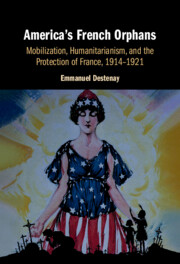Book contents
- America’s French Orphans
- America’s French Orphans
- Copyright page
- Dedication
- Contents
- Figures
- Maps
- Preface
- Acknowledgments
- Note on the Text
- Select Biographies of Those Involved in Providing Relief to France’s Orphans
- Introduction
- Chapter 1 Rescuing and Sheltering
- Chapter 2 Mobilizing Support for France’s Fatherless Children
- Chapter 3 Defending the Future of France
- Chapter 4 Writing in Wartime
- Chapter 5 Peace, Remobilization, and Memorialization
- Chapter 6 Rebuilding Devastated France
- Conclusion
- Appendices
- Bibliography
- Index
Chapter 2 - Mobilizing Support for France’s Fatherless Children
Published online by Cambridge University Press: 24 October 2024
- America’s French Orphans
- America’s French Orphans
- Copyright page
- Dedication
- Contents
- Figures
- Maps
- Preface
- Acknowledgments
- Note on the Text
- Select Biographies of Those Involved in Providing Relief to France’s Orphans
- Introduction
- Chapter 1 Rescuing and Sheltering
- Chapter 2 Mobilizing Support for France’s Fatherless Children
- Chapter 3 Defending the Future of France
- Chapter 4 Writing in Wartime
- Chapter 5 Peace, Remobilization, and Memorialization
- Chapter 6 Rebuilding Devastated France
- Conclusion
- Appendices
- Bibliography
- Index
Summary
No foreign humanitarian organization garnered more support from Americans during (and after) World War I than did the Fatherless Children of France Society. From New York City, the Franco-American private philanthropic organization rapidly raised a wave of humanitarian response for the children of France’s war dead, doing so through strategic communication and tireless networking. Members of the FCFS toured US cities, states, and territories, opening chapters and addressing assembled crowds, constantly collecting funds. Speakers vividly described the plight of starving babies in devastated France and invited those who had witnessed the trauma of children to testify. Much of the campaigning was done by women representing local committees. Americans were offered a choice on how to spend their humanitarian dollars. From the moment they became sponsors, they could be involved in the process of selecting their orphans. Most importantly, the FCFS reached the wealthy, middle, and working classes alike. In involving school children, laborers, and members of churches, clubs, and associations, the FCFS encouraged a spirit of cooperative – and sometimes competitive – humanitarianism. As a result, the FCFS mobilized large sections of US society to “adopt” some 300,000 French children who were victims of war and kept the aid flowing from 1915 to 1921.
Keywords
- Type
- Chapter
- Information
- America's French OrphansMobilization, Humanitarianism, and the Protection of France, 1914–1921, pp. 48 - 84Publisher: Cambridge University PressPrint publication year: 2024

